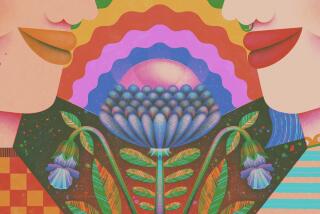GARDENING : New Varieties Have Geranium Interest Blooming
- Share via
Most people are familiar with the old-time geranium favorites--the scarlet zonals for bedding and window boxes, the ivy-leaved types for hanging baskets and the regals for showy, sumptuous blooms. But today there is increasing interest in the less usual forms, including new colors, miniatures that are ideal for patio gardening and the scented-leaved types with their subtle beauty.
The most familiar geraniums, such as the red-flowered houseplant, are known as zonal, or garden geraniums. They are named for the dark ring, or zone, that is often found on the leaves. Zonal geraniums are easy to care for and cultivate their bloom for months. They make bushy plants, usually growing to a height of two feet, and are popular in pots and window boxes and as formal bedding plants.
Aside from the familiar red, white or pink varieties, zonal geraniums come in vibrant scarlets, crimsons and magentas and more muted tones such as cream, apricot or pale lavender. Particularly lovely are the bicolored flowers, where the petals can be either edged, speckled or softly suffused with a contrasting color.
Most zonal geraniums bloom from early summer to early autumn, but in the Southern California climate, they generally bloom year-round.
There are many cultivar zonals, each with its own character.
Dwarf and miniature zonals were developed after World War II to meet the need for small plants to grow in the then-new smaller homes and greenhouses. Technically, miniatures are a maximum of five inches high from the soil to the top of the foliage, and dwarfs are no more than eight inches high. Flowers can be single, semidouble or double, and come in the same colors as the full-sized zonals.
Some miniatures and dwarfs carry diminutive flower heads; others carry relatively large trusses. The leaves can be plain green, gold or heavily zoned, but many have dark leaves. There are also ornamental-leaved type zonals grown specifically for their exceptionally attractive leaves, and in some cases the flowers are removed. (Ornamental-leaved types need more careful feeding, watering and lighting).
In addition to the popular zonal geraniums, there are many unusual varieties, such as Irene, Deacon, Rosebud, Cactus-flowered and Stellar types.
The robust, strong-stemmed, naturally bushy Irene varieties are American in origin and ideal for bedding. They have lush foliage and large, long-lasting, semi-double or double flowers on stiff stalks. Because of their vigorous growth habits, they need generous feeding and watering.
Deacon varieties are the result of crossing a miniature zonal with any ivy-leaved cultivar. Most are dwarf, bush and compact, but if grown in generous-sized containers, they respond by growing relatively large. They have prolific double flowers, starting earlier in spring than other zonals, and need generous feeding.
Rosebud forms were developed in the 19th Century. They have tight double blooms, so densely packed with petals that they cannot open fully, creating a rosebud effect. “Apple Blossom” is a light pink and cream rosebud and quite lovely. To prevent the plants from growing lanky, they should be frequently pinched out.
Cactus-flowered types, called poinsettia geraniums in the United States, have single or double flowers with twisted, pointed quilled petals. “Spitfire” is a bright red poinsettia geranium that also needs to be pinched out regularly. Stellar types are Australian in origin and have flowers with dainty, quilled petals, the top two forked and the lower ones serrated. If the dense, star-shaped foliage is not thinned periodically, the center of the plant may grow moldy.
Ivy-leaved geraniums are leathery, waxy-leaved plants that are best known as trailing, cascading or hanging basket geraniums. Their shieldlike, lobed leaf resembles ivy, hence its common name. Ivy-leaved geranium varieties can be grown as permanent plants in mild conditions; frequent pinching out from an early age encourages dense growth. They’re usually grown in window boxes or hanging baskets but also can be used as ground cover or trained against walls, indoors or out.
Their flowers are single, semi-double or densely double, and are more limited on color range than zonals, with mauves and pinks predominating and true red and purples rare. They are relatively greedy, of both water and food, but are otherwise easy to care for. “Rouletts” is a coral-colored double-blossom and easy to grow.
Regal pelargoniums are the most dramatic flowers in the geranium family. They are also known as show, fancy, grandiflora or decorative pelargonium, and in America as Lady or Martha Washington pelargoniums. They have unzoned, slightly furry, serrated leaves and huge, showy flowers. Regals were so-called because many of them had their 19th-Century origins in the royal greenhouses of Sandringham, Norfolk, England.
The flower trusses contain fewer but larger blooms than the zonals, each trumpet-shaped floret growing up to two inches across. Most are single, although each floret can have more than five petals, and their ruffled, fringed or frilly edges create the impression of double blooms. The color range includes white, pink, salmon, mauve, crimson, scarlet, orange, violet and near black--all but true blue and yellow. Many are bicolored with richly contrasting tints, veins or blotches.
Angels are classed as miniature of dwarf regals, known as pansy-faced geraniums in the United States. All have single, five-petalled flowers, mostly in the mauve color range, often marked with a deeper color. They are compact and long-flowering.
Scented-leaved geraniums have become more widely available in the past decade. Many are species collected from the wild, while a few are hybrids. The foliage ranges from modest to attractive and is scented or, technically, aromatic.
Originally nature’s device to repel foraging animals, the scent of most cultivated forms is pleasant and includes aromas of lemon, apple, orange, peppermint, pine, rose and other less defined aromas. The leaves vary from huge to tiny, solid to deeply lobed or lacy, shiny or mat or velvety, and some are variegated. The flowers of most types are small and mauve-colored with darker markings.






